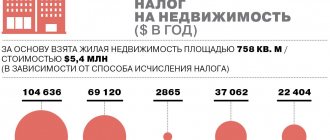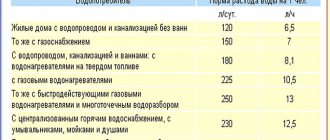A blog participant asked the question:
What to do if the management organization does not provide economically justified calculations for work and services in the tariff for 2019, according to clause 31 of RF PP No. 491. The prosecutor's office and the administration and the State Housing Property Committee support them, stating that they presented you with bare numbers, this is a calculation.
The situation is ambiguous and everything stems from the imperfection of legislation. And more about that below...
When approving new tariffs, managers are required to justify the tariffs
When approving new tariffs, managers must follow the notification procedure with the provision of calculations and economic justification - I wrote about this in an earlier article.
We are talking about tariffs for services and work of managers (for example, the line “housing maintenance”), and not about utility tariffs.
But everything would be fine if the legislator provided for what the calculation and economic justification should look like.
The manager is obliged before the meeting to provide the owners with a calculation (estimate) for the new tariff proposed by the organization 30 days in advance. There are no requirements for the content of the calculation in the law, so in essence it can be a table indicating the type of work and its cost in the proposed tariff.
Whether the manager is obliged to detail the list of works and services is also not directly resolved. But in this case, you should refer to the management standard (Resolution of the Government of the Russian Federation of May 15, 2013 No. 416).
Pricing in the electricity industry in 2020: practical recommendations
Economic fundamentals of the functioning of the Wholesale and Retail energy markets.
New model of the electricity market. Regulatory and legal acts in the field of pricing in the electric power industry.
- Recent changes in legislation in the field of regulation of the activities of energy companies in the wholesale market.
- Long-term capacity market. Selection of projects for the implementation of measures to modernize generating facilities of thermal power plants.
- Current issues of regulation of retail electricity markets (changes in legal regulations).
- Analysis of the pricing system in the electric power industry: retrospective, main trends, key development issues.
- A mechanism that ensures the modernization of generating assets. Decree of the Government of the Russian Federation dated January 25, 2019 N 43.
Features of the functioning of electricity markets in the Russian Federation under the conditions of antimonopoly regulation.
- The procedure for implementing antimonopoly control on the wholesale electricity (capacity) market (introduction of the institution of warnings. Results of established practice).
- Criteria for recognizing the position of an economic entity as dominant.
- Identification of cases of price manipulation on the wholesale electricity (capacity) market. Examples from practice.
- Peculiarities of pricing in electricity (capacity) markets.
- Tariff calculator as a tool for consumer control of the legality of invoices issued.
Features of the functioning of retail electricity markets.
- Subjects of retail electricity markets.
- Features of the activities of guaranteeing electricity suppliers.
- Features of contractual relations between energy sales organizations and consumers.
- Antimonopoly control and procedure for identifying cases of price manipulation on the retail electricity market.
- Tariff calculator as a tool for consumer control of the legality of invoices issued.
- Control over information disclosure standards by subjects of the wholesale and retail electricity markets.
Formation of tariffs for services for the transmission of electrical energy using the “boiler” method.
- Changes in regulations and methodological documents on calculating tariffs for electricity transmission services and technological connection to electrical networks.
- Principles for setting tariffs for electricity transmission services (“boiler”, “cascade”, payment of losses, transit).
Features of formation of tariffs for electricity transmission services.
- Formation of tariffs for electric energy transmission services. The method of return on invested capital (RAB-regulation) and the method of long-term indexation of the required gross revenue. Long-term parameters of territorial network organizations.
Approaches to benchmarking network organizations (cost benchmark method).
- World practice of applying the method and methodology of comparison with an analogue. Principles for setting tariffs for electricity transmission services.
Features of formation of tariffs for electricity transmission services.
- Features of the formation of an economically justified level of tariffs for services for the transmission of electrical energy by voltage levels.
Features of accounting for investment costs in the tariffs of regulated organizations (AIISKUE, acquisition of electric grid facilities). Accumulated smoothing.
- Features of taking into account indicators of the consolidated forecast balance of electrical energy and power when calculating unified (boiler) tariffs for services for the transmission of electrical energy.
Review of key changes in regulations and methodological documents on calculating tariffs for electricity transmission services.
- Cross-subsidization (draft resolution of the Government of the Russian Federation, draft order of the Federal Antimonopoly Service of Russia).
- Maximum maximum and minimum levels of prices (tariffs) (Federal Law No. 300 of 08/02/2019 “On Amendments to the Federal Law “On Electric Power Industry”, draft resolutions of the Government of the Russian Federation, draft orders of the Federal Antimonopoly Service of Russia).
The procedure for the formation of a consolidated forecast balance of electrical energy and capacity (draft order of the FAS Russia).
- Differentiation of tariffs of PJSC FGC UES (draft Federal Law, draft resolution of the Government of the Russian Federation). Tariff discrimination (proposals of the Federal Antimonopoly Service of Russia).
Investment activities of regulated organizations:
- The procedure for approving investment programs. The procedure for adjusting investment programs. Features of accounting for investment programs in regulated prices (tariffs).
- The procedure for monitoring the implementation of investment programs. Formation of a consolidated forecast balance of electrical energy and power for the constituent entities of the Russian Federation: goals and objectives of the formation of a consolidated forecast balance of electrical energy and power.
The powers of the Federal Antimonopoly Service of Russia to formulate a consolidated forecast balance of electrical energy and capacity.
- The procedure for approving the consolidated forecast balance of electrical energy and power. Features of the formation of a consolidated forecast balance of electrical energy and capacity for the constituent entities of the Russian Federation.
Pricing policy of energy sales and their regulation.
- Differentiation of sales markup. New methodological approaches. Calculation of sales allowances using the method of comparing analogues.
- Main expenses associated with energy sales activities.
Practice in calculating regulated tariffs in the electric power industry.
- Long-term regulation of network organizations using various methods.
- Calculation of long-term tariffs for electricity transmission.
- Calculation of tariffs for electricity transmission services, sales surcharges, calculation of tariffs for the population.
Unmetered (non-contractual) consumption of electrical energy.
- Assessment of the company's performance in identifying unmetered (non-contractual) consumption of electrical energy within the tariff company.
The procedure for transferring electricity consumers for service from one energy sales organization to another.
Practice of considering disagreements and pre-trial disputes regarding electricity tariffs. Unsolved problems of the retail market: cross-subsidization and non-payments.
The list of works and services is required
Section 3 of the Management Standard provides for the obligation of managers to provide owners with a draft list of services and works for approval by the owners.
Also, in order to confirm the need to provide services and perform work provided for by the draft list of services and work, the management organization, partnership or cooperative, at the request of the owners of premises in an apartment building, are required to submit an inspection report of the technical condition of the apartment building, as well as other documents containing information about the identified defects (malfunctions, damages), and, if necessary, conclusions of expert organizations.
As a result, if the manager has provided you with a calculation without specifying specific work, then we request a draft list of works and services, as well as inspection reports, which will indicate the need to perform certain works, the presence of defects in common property, etc.
The article will be useful: Who is responsible for leaks of the foundation, walls into the basements
Formation of tariffs for household services
Household services are a variety of jobs that have emerged from the household into an independent industry as a result of the social division of labor. Household services can be classified into industrial (repair, sewing clothes, shoes, dry cleaning, dyeing, etc.) and non-industrial (hairdressing salons, rental services).
The formation of tariffs for household services has a number of features that take into account the specifics of the industry and are determined by the established practice of their calculation. In terms of their composition, tariffs for household services are similar to the selling prices of enterprises and contain almost the same set of components. Since the sphere of activity of consumer services is of a clearly local nature, prices for them should take into account to the maximum extent the needs of the population of a certain area and the regional specifics of cost formation. Currently, pricing for services combines the independence of enterprises with price regulation by local authorities.
State regulation of tariffs for household services in the transition period is necessary due to the fact that a small number of state-owned enterprises operated in this area. To create full-fledged market relations, local authorities should not only regulate tariffs for services, but also stimulate the creation of public service enterprises to create normal competitive conditions. Tariffs for the services of consumer service enterprises are formed at a higher level, since the work is of an individual nature, increasing the costs of the enterprise, high quality of service, and shorter order execution times.
Thus, we can identify the main factors influencing the final cost of the service: category of the enterprise; degree of urgency of order execution; seasonal changes in population demand for certain household services during a certain period of the year; the degree of proximity of services to the customer; social significance of services.
The procedure for setting prices for household services provided to the population by organizations of all forms of ownership is established by the Regulations on the formation of maximum prices and tariffs for household services, approved by the Resolution of the Ministry of Economy of the Republic of Belarus dated July 22, 1999. No. 79, taking into account additions and changes.
In accordance with the Regulations, tariffs for household services are formed on the basis of the planned cost, all types of established taxes and non-tax payments, profit, taking into account the quality of services and market conditions, as well as taking into account industry characteristics.
Prices for household services are developed at the consumer service enterprises themselves and are approved by the directors of these enterprises. The formation of prices and tariffs for household services is carried out by all organizations on the basis of economically sound norms and standards for basic material and labor costs, developed and approved by the state association "Belbyt" or the Ministry of Trade, which includes this association.
In accordance with established practice, prices for household services are set, as a rule, based on the cost of processing, i.e. without taking into account in the cost price the costs of basic materials, spare parts, and accessories. These costs are determined separately at purchase prices with the addition of the actual costs of their acquisition (transport...). The order price (Zz) is equal to:
,
where is Mosn. – cost of basic materials, spare parts, accessories with the addition of transportation and procurement costs;
Tsu – price of the service.
In turn, the price of a service provided by a consumer service enterprise consists of three components:
,
where Sobr. – cost of processing,
P – profit,
KN – indirect taxes and payments.
For enterprises with a dominant position in the services market, a maximum rate of return of 25% is established.
Indirect taxes and payments are paid on the volume of services sold without taking into account the cost of materials and spare parts paid by the population.
At the same time, taking into account the social orientation of a number of types of services, the state provides a number of benefits in the taxation system. Socially significant services include: hairdressing services (except for salon and luxury salon services); services of baths and showers; funeral services (within the minimum funeral ritual); physical education and health services for children under 16 years of age; dry cleaning; documentary photo; laundries; Shoe repair.
An example of calculating the tariff for household services is presented in Appendix 4.
In order to ensure the stimulating role of prices in improving the quality of household services, reducing order execution times, and developing progressive forms and types of service, organizations can apply surcharges and discounts to tariffs for household services. The amount of the surcharge depends on the timing of the order, determined by Belbyt Order No. 418 dated December 10, 2004. The procedure for applying discounts and their sizes are developed and approved by organizations independently.
Previous7Next
About the service
Calculation of tariffs for the operation of a cottage village is a service for calculating economically justified tariffs for work and services for comprehensive maintenance of the territory and engineering infrastructure of a cottage village or residential complex.
Regulations for the provision of the service: - sending the customer a request for data and information necessary for the provision of the service; — receiving data and information from the customer on paper or in electronic form; — performing calculations and recording the results in a report; — sending the results of services provided to the customer.
Composition of the service (contents of the report):
- Regulatory list of works and services for comprehensive maintenance of the territory and engineering infrastructure of a cottage village (regulated by the current legislation of the Russian Federation and compiled taking into account the customer’s data) in the context of the following work performed and services provided:
- sanitary mechanized cleaning of the territory of the cottage village
- sanitary manual cleaning of the territory of the cottage village
- external improvement of the territory of the cottage village
- landscaping of the territory of the cottage village
- 24-hour security of the territory of the cottage village
- solid waste removal
- street lighting of the cottage village territory
- maintenance, maintenance and repair of low-current networks and devices
- maintenance, maintenance and repair of electrical networks (overhead and cable lines)
- maintenance, maintenance and repair of water supply networks (cold water)
- maintenance, maintenance and repair of sewer networks (sewer networks and storm drains)
- Calculation and formation of a production program (costs) for general operating expenses (managing the cottage community and the management organization itself), including:
- calculation of labor costs (standard number and payroll costs, including taking into account customer data)
- contributions for social needs
- costs of materials (consumption rates and costs, including taking into account customer data)
- labor safety costs (standard provision of personal protective equipment, special food and costs)
- depreciation charges (calculation based on customer data for fixed assets)
- costs for repair and maintenance of machinery and equipment (calculation based on customer data)
- other direct costs (consumption rates and costs for office supplies, calculation based on customer data of low-value and wearable items - MBP, costs for paying for services of third-party organizations)
- Calculation and formation of the production program (costs) for each work and service from the list of works and services specified in clause 1, including:
- calculation of labor costs (standard number and payroll costs, including taking into account customer data)
- contributions for social needs
- costs for raw materials (consumption rates and costs, including taking into account customer data)
- fuel costs (consumption and costs, including taking into account customer data)
- tools and equipment (standard provision of cleaning or household equipment, tools and costs, calculation based on customer data of costs for equipment and mechanisms)
- labor safety costs (standard provision of personal protective equipment, special food and costs)
- depreciation charges (calculation based on customer data for fixed assets)
- costs for repair and maintenance of machinery and equipment (calculation based on customer data)
- purchased products (calculation based on customer data)
- other direct costs (calculation based on customer data)
- general operating expenses (calculation taking into account the customer’s data according to the chosen method of distributing general operating expenses for the works and services of the list specified in clause 1)
- Calculation of the full cost and economically justified tariff for each work and service from the list of works and services specified in clause 1 (according to the main cost items of the economic classification)
- Calculation of estimates of income and expenses for each work and service from the list of works and services specified in paragraph 1 (according to the main cost items of the economic classification)
- Calculation of economically justified tariffs for work and services for comprehensive maintenance of the territory and engineering infrastructure of a cottage village (summary table for all works and services on the list specified in paragraph 1)
- Calculation of the consolidated estimate of income and expenses for comprehensive maintenance of the territory and engineering infrastructure of the cottage village (consolidated estimate for all works and services on the list specified in paragraph 1)
- Calculation and formation of the staffing table of the organization that manages and operates the cottage village (based on calculations of labor costs made in accordance with clauses 2 and 3)
The service is intended for an enterprise or organization that carries out or intends to manage, maintain, maintain and operate a cottage community or residential complex, regardless of the form of ownership and legal form.
The service is provided within 20 days.
Calculations of tariffs for the operation of the following cottage villages have already been completed:
Residential complex “Dream” (Moscow region, Dmitrovsky district, Ozeretskoye village, 23 km from Moscow). Cottage village "Priozerye" (Moscow region, Istrinsky district, 55 km from the Moscow Ring Road along Novorizhskoe highway). Cottage village "Ecodolye Belkino" (Kaluga region, Borovsky district, Belkino village, 89 km from the Moscow Ring Road along the Kievskoe highway). Residential complex "Sukhanovo Park" (Moscow region, Leninsky district, 5 km from the Moscow Ring Road along the Varshavskoe highway). Cottage village "Zaytsevo Estate" (Moscow region, Odintsovo district, 18 km from the Moscow Ring Road along the Minsk highway). Cottage village "Count Ponds" and the 1st stage of the cottage village "Grafskie Les" (Moscow region, Naro-Fominsk district, 20 km from the Moscow Ring Road along the Kyiv highway). Cottage community “Zolotaya Gorka” (Sverdlovsk region, Sredneuralsk, district of Kirpichny village). Cottage village "Dubrava" (Penza region, Penza, Sovkhoz street - technical school 60Ya). Cottage villages “Forest Landscape” and “Forest Landscape 2” (Moscow region, Troitsky district, New Moscow, 25-30 km from the Moscow Ring Road along the Kyiv highway). Cottage community "Onegino" (Moscow region, Istrinsky district, 25 km from Moscow along the Novo-Rizhskoe highway, village Obushkovskoye, near the village of Voronino). Cottage village "Brusnika" (Sverdlovsk region, Sysertsky district, area of the village of Cherdantsevo). Cottage community "Vita Verde" (Moscow region, Mytishchi district, 15 km from the Moscow Ring Road along Dmitrovskoye Highway). Cottage village "Kingdom-Kingdom" (Leningrad region, Vyborg district, town of Roshchino). Cottage village "Petrovsky" (Moscow region, Krasnogorsk district, village of Petrovo-Dalneye, 15 km from the Moscow Ring Road along Ilinskoye Highway). Cottage community "Fedoskino Park" (Moscow region, Mytishchi district, 15 km from the Moscow Ring Road along the Dmitrovskoe highway northeast of the village of Semenishchevo, s/p Fedoskinskoye). Cottage village “Golden Sands” (Moscow region, Mozhaisky district, 110 km from the Moscow Ring Road along the Minsk highway, Goretovskoye village, southeast of the village of Glazovo). Cottage community "Nikolino Park" (Krasnodar region, Krasnodar, Stalingradskaya street). Cottage village "Petrovskie Lakes" (Voronezh region, Voronezh, Somovo microdistrict). Cottage community "Count Ponds" and cottage community "Count Forest" (Moscow, Pervomaiskoye settlement, Kamenka village, 20 km from the Moscow Ring Road along the Kievskoye Highway).
Examination of the validity of tariffs
The payment system for utility services is imperfect. Citizens would like tariff calculations to be transparent and understandable. A low competitive environment gives management companies a free hand, oppressing ordinary citizens who do not understand where extortionate payments come from. There is no point in tolerating further; there is a tariff examination - a service with the help of which it is possible to find out the actual cost of services.
Examination of the validity of tariffs is a sure way to reduce costs for consumed resources for individuals and legal entities. ANO "Standard Expert" conducts research professionally, guided by the norms of Russian legislation.
The relevance of the topic of containing rising tariffs is not decreasing, but rather increasing. Therefore, there are many people who benefit from the tariff examination ordered from the Center for Independent Expertise.
We audit tariffs:
- for hot and cold water supply;
- drainage;
- sewerage;
- current repairs;
- elevator maintenance;
- waste removal;
- operational maintenance of housing stock;
- heat supply;
- energy supply:
- gas supply.
Our specialists will protect the interests of citizens and organizations, understand tariff formation, check their economic feasibility, and issue an appropriate conclusion. Based on the results of the examination, it will be possible to file a claim with the organization of the utility complex to resolve any disagreements that have arisen.
Below are the wording of questions to pose to an expert:
- What is the cost of services for the transmission of 1 Gcal of thermal energy?
- What is the amount of the cost of services for the transmission of electrical energy (provided that there is no single-rate tariff for services for the transmission of electrical energy), subject to deduction from the cost of electrical energy paid under the purchase and sale agreement for electrical energy No. “...” concluded between “...” and “...” for the period “...”, taking into account the single-rate tariff for electrical energy “...” agreed upon by the parties to the contract?
- What is the value of the cost of purchasing a unit of electrical energy, taking into account power, which was adopted when establishing the single-rate tariff "..." for electrical energy for "..." in the period "..." to be used when calculating the unregulated price for electrical energy (power)?
- What amount of gas during the period "..." was supplied from "..." and accepted by "...", including indicating how much gas was actually accepted by the defendant's counterparties, the amount of standard technological losses, the amount of gas used for the defendant's own needs?
- What amount of gas during the period was supplied from "..." and accepted "..." based on the volume, gas consumption corresponding to the design capacity of unsealed gas consuming installations, including indicating how much gas was actually accepted by the defendant's counterparties, the amount of standard technological losses, the amount of used gas for the defendant's own needs?
- In what volume during the period “…” did the organization supply “…” thermal energy to consumers (in Gcal) and what is its actual cost?
- What amount of money was received by the organization for the hot water supply supplied to consumers “...” for the period “...”?
The cost of the examination depends on the problem being solved, the number and parameters of the objects being examined. You can find out the cost of the work you need by contacting us for a consultation.
Estimate for major repairs of a residential building
What method should be used to prepare estimates for major renovations of residential buildings?
To determine the cost of major repairs of residential apartment buildings, design documentation is developed in accordance with the Regulations on the composition of sections of design documentation and requirements for their content, approved by Decree of the Government of the Russian Federation dated February 16, 2008 No. 87. If the nature of the repair work does not require the development of drawings, then the composition The design documentation contains two sections: Sect. I - explanatory note with initial data for major repairs and section. II - estimate for major repairs.
Estimated documentation for major repairs is drawn up in prices prevailing at the time of its preparation in accordance with the Methodology for determining the cost of construction products on the territory of the Russian Federation (MDS 81 - 35.2004), approved by Decree of the State Construction Committee of Russia dated 03/05/2004 No. 15/1, and must contain: summary estimate calculation, object and local estimates.
Local estimates are intended to determine the estimated cost of the object being repaired. A local estimate is a primary estimate document for certain types of work and costs, and it can be drawn up both for a separate object and for site-wide work. The local estimate is based on the volumes that are determined as part of the working documentation or working drawings.
An object estimate is a document that includes data as a whole for the object being repaired, taken from local estimate calculations and local estimates.
The summary estimate of the cost of an object is calculated on the basis of object estimates and calculated object estimates for individual types of costs.
As for budgeting methods, one of the most common methods is the resource method. When using this method, the estimate is calculated using current (forecast) prices and tariffs (rates) of cost elements that are necessary to complete the work. The calculation is carried out on the basis of the following data: the need for materials, which is expressed in natural meters, the operating time of construction machines, the labor costs of workers, the consumption of energy carriers used for technological purposes, etc. These resources are calculated on the basis of design materials, as well as relevant regulatory sources (reference books). Also, the base-index method can be used to prepare estimates. This method is based on the application of a system of current and forecast indices in relation to the value that was determined in the basic price level. If the estimate documentation for major repairs consists of only one local estimate, then a consolidated and object-based estimate is not drawn up, and the costs for the chapters of the consolidated estimate are taken into account at the end of the local estimate.
Local estimates are drawn up on the basis of the scope of work determined from the drawings, or on the basis of inventories of work (defect sheets) signed by the customer and the design organization.
Inventory of work must be attached to the estimate documentation as part of the design documentation for major repairs. According to clause 4.7 section. IV of this Methodology, it is recommended to include in local estimates for repair work the coefficients applied to similar work in new construction, taking into account the peculiarities of the technology for carrying out repair work. Seal




